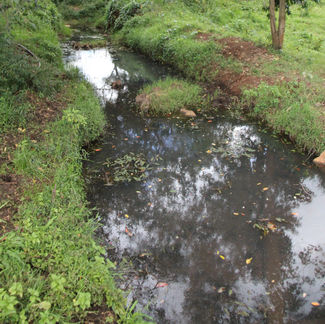

MATERIALS
WOOD
SOIL
SUN BRICKS
AGGREGATE
SAND
WATER
The Rift Valley Resource Center is built almost entirely from local materials surrounding the site. The construction is primarily wood and brick with a concrete slab and metal roof. Aggregate for the concrete was sourced from a nearby quarry, and sand and cement were truck delivered. Water and soil from the site were used to complete the concrete mixture. A slurry was made on the ground and hand-shoveled into place. The bricks were sun baked on the site, and we felled two trees, 250 meters from the site. We hired a man with a chain-saw to cut the tree into properly-sized members. The wood is naturally water resistant, and highly desirable for building. We wanted to use local materials in order to lower the embodied energy of the building. As well, we wanted the surrounding community to be proud to know this community hub was built from resources they had access to and could use again very easily. The materials were traditional to the area, but new in their assembly.
With the help of a nearby vocational school, we were able to teach local people about the construction techniques used on site. We employed local tradespeople and hired an engineer from the closest University in Eldoret, Kenya to use their knowledge of how to build in combination with ours. Seemingly new to the area, we found a membrane in Eldoret, and motorbiked it to the site. We taught workers how to properly lap the material, and explained that it would control moisture in the slab. A neighbouring hut with a concrete/mud floor often had moisture issues, so we wanted to avoid this in our building.
During our time in this beautiful community, we were so amazing by how kind and friendly everyone was. We were also incredibly impressed by the strength of these people. Shoveling aggregate and heavy, wet slurry seemed almost effortless to them, while Alex and I struggled to shovel for more than five minutes at a time. We began our portion of the construction by hand-laying large stones for the base of the slab. Soil was then shoveled over this first layer, and then compacted with a diesel-powered compressor. We suggested a compressor be rented to do this to help prevent any future shifting of the slab which would increase cracks. After the soil was compacted, we laid the membrane into place, set up the board-forms, and shoveled the concrete into place. During the process, sketching in our notebooks to help explain the process was an incredibly helpful tool. Never under-estimate the power of drawing to help communicate ideas.
The building is successfully off the grid by making use of the nearby stream for grey water uses. The roof collects clean drinking water which is collected in a trench drain and carried to cisterns. Solar energy by means of a few solar panels are on the neighbouring building and provide power to the site.
We felt is was important to build something the community could learn from and repeat without any complex or expensive building methods. People on the site were very excited about the design and courtyard concept. The building now draws people from around the community to gather and eat around the shaded courtyard spaces, while runners from around the world stay to train at the high altitude the valley has to offer. We truly believe the Rift Valley Resource Center is a sustainable building, but also one which the community is thrilled about, and one which proves building locally and smartly is completely possible when a design adapts to the conditions in a given area.
























